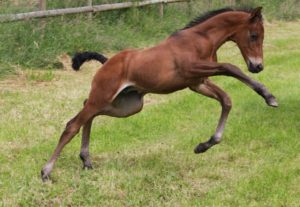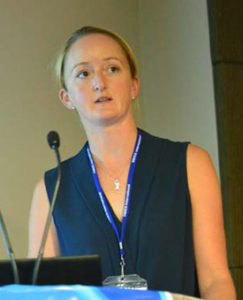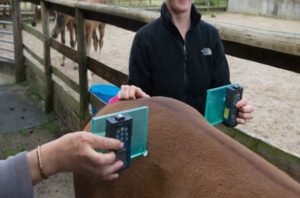 Research is key to improving animal welfare and as part of the MSc qualification practitioners are required to produce their own research project. After much consideration I chose to study how early in a horses life physical asymmetries start to occur to try to establish if treating horses before they start work would have potential benefits. I had the opportunity to present my research at the 3rd International Veterinary conference in London. Below is the scientific abstract, below that is a more readable translation of the work. At the bottom of this page you will find references to other interesting research and an outline of what each study found.
Research is key to improving animal welfare and as part of the MSc qualification practitioners are required to produce their own research project. After much consideration I chose to study how early in a horses life physical asymmetries start to occur to try to establish if treating horses before they start work would have potential benefits. I had the opportunity to present my research at the 3rd International Veterinary conference in London. Below is the scientific abstract, below that is a more readable translation of the work. At the bottom of this page you will find references to other interesting research and an outline of what each study found.
Title: A preliminary study to investigate the prevalence and progression of pelvic axial rotations among neonate foals
Stroud R. MSc, Ellis J. MSc, Hunnisett A. PhD MPhil, Cunliffe C. DC PhD
 Purpose of work: This study aims to identify the presence or absence of pelvic axial asymmetry in the neonate foal, and its progression during the first nine weeks of life, using quantitative data. The importance of symmetrical development and skeletal alignment in the equine athlete and its relationship with career longevity and injury is widely acknowledged. However, the comparative musculoskeletal development in a foal should demand equal, if not more, consideration of structural symmetry.
Purpose of work: This study aims to identify the presence or absence of pelvic axial asymmetry in the neonate foal, and its progression during the first nine weeks of life, using quantitative data. The importance of symmetrical development and skeletal alignment in the equine athlete and its relationship with career longevity and injury is widely acknowledged. However, the comparative musculoskeletal development in a foal should demand equal, if not more, consideration of structural symmetry.
Method: Measurement of the tuber coxae heights in relation to level ground were taken of ten healthy subjects, at three time periods: 0-1 week; 4-5 weeks and 8-9 weeks of age. A novel method of measurement was used in the form of two laser measures applied simultaneously. Between the first and second data collection foals received their first turnout. A questionnaire provided qualitative data in order to analyse potentially influential variables. Symmetry indices (SI) of datasets were calculated and analysed by statistical analysis.
Data (means, variation etc): There was a significant presence of axial rotation of the pelvis within 0-1 week of age (mean SI = 0.337 ± 0.25; p = 0.002). These asymmetries did not change significantly between week 0-1 and week 8-9. There was no significant difference of asymmetry between week 0-1 and week 4-5 suggesting turnout did not have an effect on the prevalence of pelvic misalignments in foals. Foals of mares that gave birth standing up displayed significantly greater asymmetry of the pelvis during week 0-1 when compared to foals of mares that gave birth in a recumbent position (mean SI ± SD: recumbent n = 8; 0.2497 ± 0.659; standing n = 2; 0.686 ± 0.4798; p = 0.04).
Stats info: Symmetry indices were calculated from raw data and were statistically analysed using the following statistical tests: Wilcoxon matched-pairs signed-rank; one sample t-test; paired t-test; Spearman rank test; Mann-Whitney test.
Conclusions: This study shows evidence of significant pelvic axial asymmetry from birth to 8-9 weeks of age in foals. Further research is required to ascertain if pelvic axial asymmetry was caused by the birth process or from attempts to stand and subsequent locomotory efforts. Any future research to establish the cause of laterality should be focused on neonate foals in order to further test the theory of birth trauma and of genetic predisposition and thus eliminating the influence of training and handling. Linking potential indicators of laterality together, such as suckling preference, limb protraction, limb preference, anatomical measurements and axial skeletal asymmetry would help to establish an overall or selective lateral bias. If axial skeletal asymmetry is shown as a strong indicator of laterality, then corrections of misalignments may reduce lateral bias.
A more readable overview:-
The importance of symmetrical development in the horse during training is widely acknowledged. We all know to work our horses on both sides so that they develop and strengthen evenly. However, it is important to consider the significant amount of development that occurs in the horse’s younger years. The development of a foal in comparison to that of the ridden horse is in fact quite extreme.
In general horses are not treated routinely by physical therapists until they start their ridden career, unless there is an injury or obvious concern. McTimoney practitioners look for misalignments, imbalances and asymmetries of the skeleton. These can cause restrictions in movement and thus uneven development of muscles and uneven strain on joints and soft tissue. If it was possible to establish how early these asymmetries occur, rectifying them may help in even development of young horses and help towards eliminating laterality or ‘one-sidedness’. 
The study focused on the rotation of the pelvis. We used laser measures to establish the heights of both tuber coxae (points of hip) in relation to the floor in 10 foals when they were just 24-48 hours old.
The study indicated that some structural asymmetries may be present in new born foals. We were unable to say whether these were caused my the birthing process or from the foal attempting to stand but the evidence showed that they were definitely present at this very early age. Therefore, assisting even growth and development of the musculoskeletal system should not be delayed until the horse begins its training. Manual manipulation may assist in minimizing assymetrical development and consequently future injury.
Interesting and important research papers…